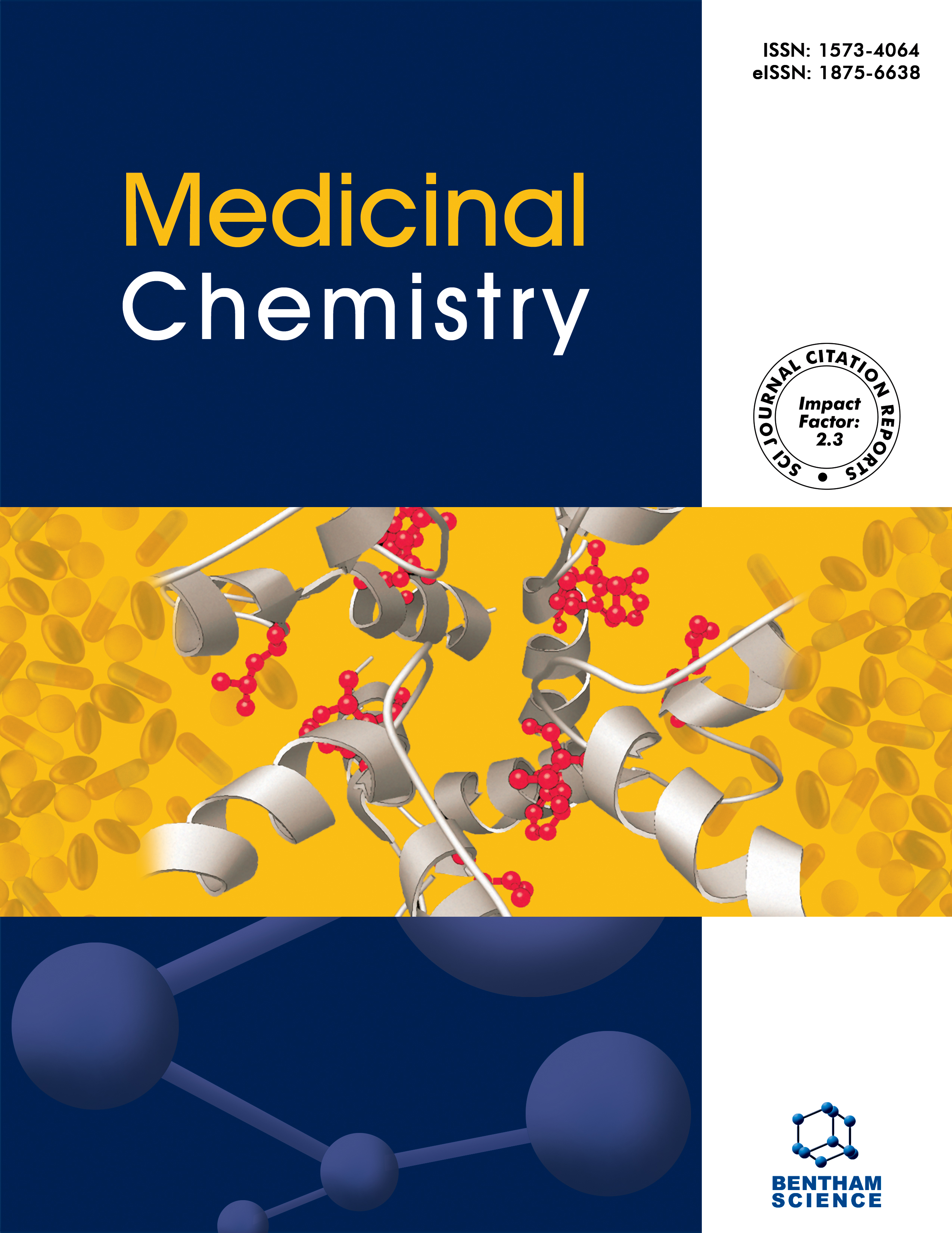- Home
- A-Z Publications
- Medicinal Chemistry
- Previous Issues
- Volume 15, Issue 4, 2019
Medicinal Chemistry - Volume 15, Issue 4, 2019
Volume 15, Issue 4, 2019
-
-
Rational Design of Colchicine Derivatives as anti-HIV Agents via QSAR and Molecular Docking
More LessBackground: Human immunodeficiency virus (HIV) is an infective agent that causes an acquired immunodeficiency syndrome (AIDS). Therefore, the rational design of inhibitors for preventing the progression of the disease is required. Objective: This study aims to construct quantitative structure-activity relationship (QSAR) models, molecular docking and newly rational design of colchicine and derivatives with anti-HIV ac Read More
-
-
-
Phenolic Imidazole Derivatives with Dual Antioxidant/Antifungal Activity: Synthesis and Structure-Activity Relationship
More LessBackground: Previous publications show that the addition of a phenolic antioxidant to an antifungal agent, considerably enhances the antifungal activity. Objective: Synthesis of novel compounds combining phenolic units with linear or cyclic nitrogencontaining organic molecules with antioxidant/antifungal activity using methodologies previously developed in the group. Methods: Several N- [1,2-dicyano-2- (arylidenami Read More
-
-
-
Antiproliferative Activity and Characterization of Metabolites of Aspergillus nidulans: An Endophytic Fungus from Nyctanthes arbor-tristis Linn. Against Three Human Cancer Cell Lines
More LessAuthors: Talea Sana, Bina S. Siddiqui, Saleem Shahzad, Ahsana D. Farooq, Faheema Siddiqui, Samia Sattar and Sabira BegumBackground: Endophytic fungi are receiving attention as sources of structurally novel bioactive secondary metabolites towards drug discovery from natural products. This study reports the isolation and characterization of secondary metabolites from an endophytic fungus Aspergillus nidulans, associated with Nyctanthes arbor-tristis Linn., a plant which has a traditional use to cure many ailments including cancer. Objective: The Read More
-
-
-
New N,C-Diaryl-1,2,4-triazol-3-ones: Synthesis and Evaluation as Anticancer Agents
More LessAuthors: Dolores S. María, Rosa M. Claramunt, José Elguero, Miguel Carda, Eva Falomir and Celia Martín-BeltránBackground: A set of 2,5-diaryl-1,2,4-triazol-3-ones was synthesized in two steps and evaluated as regards their activity in some relevant biological targets related to cancer. Objective: This study is focused on the synthesis and the biological evaluation of 2,5-diaryl-1,2,4- triazol-3-ones. In this sense, the effect of the synthetic triazolones on the proliferation of HT-29 and A549 cancer cells and on HEK non-cancer cells has been Read More
-
-
-
Spirocyclohexadienones as an Uncommon Scaffold for Acetylcholinesterase Inhibitory Activity
More LessAuthors: Ralph C. Gomes, Renata P. Sakata, Wanda P. Almeida and Fernando CoelhoBackground: The most important cause of dementia affecting elderly people is the Alzheimer’s disease (AD). Patients affected by this progressive and neurodegenerative disease have severe memory and cognitive function impairments. Some medicines used for treating this disease in the early stages are based on inhibition of acetylcholinesterase. Population aging should contribute to increase the cases of patients sufferin Read More
-
-
-
Design, Synthesis and Anxiolytic Activity Evaluation of N-Acyl-tryptophanyl-Containing Dipeptides, Potential TSPO Ligands#
More LessBackground: The 18 kDa translocator protein (TSPO), previously known as the peripheral- type benzodiazepine receptor, plays a key role for the synthesis of neurosteroids by promoting transport of cholesterol from the outer to the inner mitochondrial membrane, which is the ratelimiting step in neurosteroid biosynthesis. Neurosteroids interact with nonbenzodiazepine site of GABAa receptor causing an anxiolytic effect without Read More
-
-
-
Synthesis and Evaluation of Antifungal and Antitrypanosomastid Activities of Symmetrical 1,4-Disubstituted-1,2,3-Bistriazoles Obtained by CuAAC Conditions
More LessBackground: The trypanosomatids, such as the protozoan Leishmania spp., have a demand by ergosterol, which is not present in the membrane from mammal cells. The suppression of the synthesis of ergosterol would be a new target of compounds with leishmanicidal activity, and bistriazole has shown trypanocidal activity by this mechanism. The incidence of fungal infections has increased at an alarming rate over the last de Read More
-
-
-
Antiprotozoal Activities of Tetrazole-quinolines with Aminopiperidine Linker
More LessAuthors: Patrick Hochegger, Johanna Faist, Werner Seebacher, Robert Saf, Pascal Mäser, Marcel Kaiser and Robert WeisBackground: Human African Trypanosomiasis (HAT, sleeping sickness) and Malaria both are insect vectored tropical diseases. Only a couple of drugs is able to cure HAT, but all of them are toxic, prone to resistance and require parenteral administration. Malaria is responsible for high morbidity and mortality in humans. It is one of the global killers of children. Wide-spread drug resistance against traditional therapeutics Read More
-
-
-
Ligand-Based Drug Design: Synthesis and Biological Evaluation of Substituted Benzoin Derivatives as Potential Antitumor Agents
More LessBackground: Phosphoinositide 3-kinase α (PI3Kα) has emerged as a promising target for anticancer drug design. Objectives: Target compounds were designed to investigate the effect of the p-OCH3 motifs on ligand/PI3Kα complex interaction and antiproliferative activity. Methods: Synthesis of the proposed compounds, biological examination tests against human colon adenocarcinoma (HCT-116), breast adenocarcinoma (MC Read More
-
-
-
Novel Conjugated Unsaturated Ketones with Submicromolar Potencies Towards some Leukemic and Colon Cancer Cells
More LessAuthors: Swagatika Das, H. I. Gul, Umashankar Das, Jan Balzarini, Stephen G. Dimmock and Jonathan R. DimmockBackground: Cancer continues to be the major health burden worldwide. There is an urgent need for the development of novel antineoplastic compounds to treat this devastating condition. Various alkylating anticancer drugs have been employed in the clinic for treating cancers. Unsaturated conjugated ketones are a group of alkylators which are of significant interest as potent antineoplastic agents. Objective: Th Read More
-
Volumes & issues
-
Volume 21 (2025)
-
Volume 20 (2024)
-
Volume 19 (2023)
-
Volume 18 (2022)
-
Volume 17 (2021)
-
Volume 16 (2020)
-
Volume 15 (2019)
-
Volume 14 (2018)
-
Volume 13 (2017)
-
Volume 12 (2016)
-
Volume 11 (2015)
-
Volume 10 (2014)
-
Volume 9 (2013)
-
Volume 8 (2012)
-
Volume 7 (2011)
-
Volume 6 (2010)
-
Volume 5 (2009)
-
Volume 4 (2008)
-
Volume 3 (2007)
-
Volume 2 (2006)
-
Volume 1 (2005)
Most Read This Month
Article
content/journals/mc
Journal
10
5
false
en


